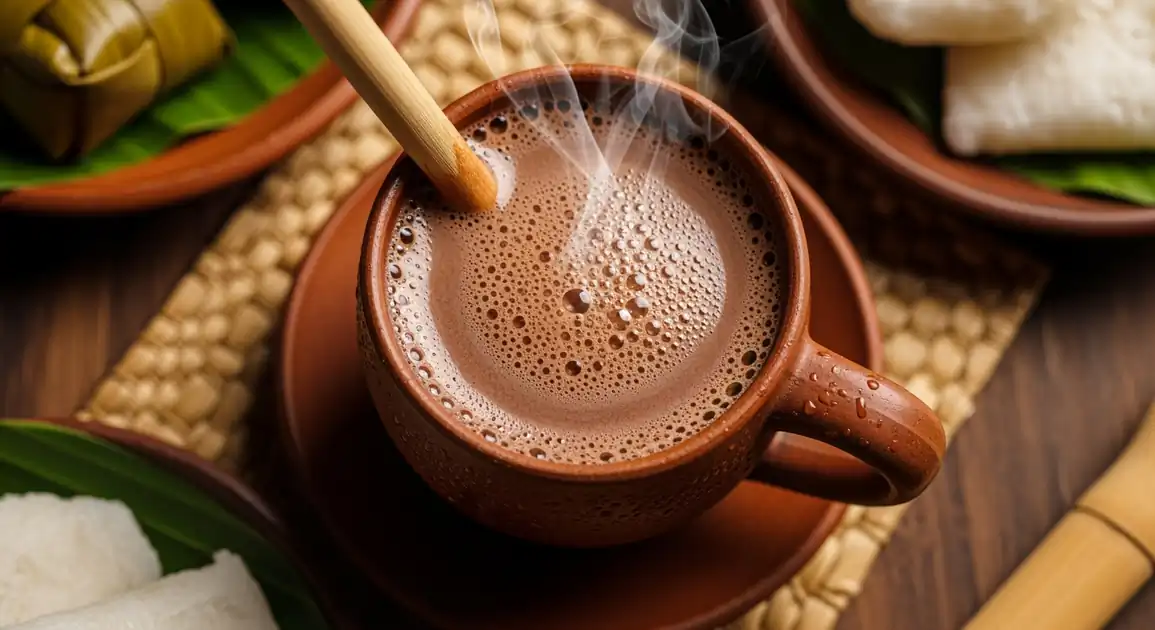Sikwate (Filipino Hot Chocolate)
Sikwate (also Tsokolate de Batirol)

Description
Bohol is known for its cacao production, making Sikwate here particularly special as it often uses locally sourced, high-quality tablea. You can find it in local eateries, resorts, and sometimes even at cacao farms.
Dietary Information
Serving information
Serving style
Served hot in a cup. Often paired with local delicacies like 'puto' or 'suman'. Some resorts might offer it as a welcome drink.
Quick facts
Breakfast places: Morning (7 AM - 10 AM). Restaurants/Cafes: All day. Farms: Daytime tour hours.
Safety Tips
What to Look For
-
Prepared fresh upon ordering
Ensures the drink is served hot and hasn't been sitting, preserving flavor and minimizing any potential bacterial growth (though boiling makes it generally safe).
-
Use of real tablea (visible tablets or info from vendor)
Guarantees authentic flavor. Avoid places using instant powders which might have many additives.
-
Served steaming hot
Sikwate is meant to be enjoyed hot. Proper temperature ensures the tablea fats are well emulsified.
-
Clean cups, 'batirol', and preparation area
General hygiene is always important. Ensure utensils and serving cups look clean.
-
Use of a 'batirol' for preparation
Indicates a traditional preparation method focused on achieving the right texture, often a sign of quality.
What to avoid
-
Sikwate kept lukewarm in a large dispenser for hours
Flavor and texture degrade over time. Freshly prepared is always better.
-
Excessively sweet taste
Sometimes used to mask lower quality, less flavorful tablea. Good Sikwate balances bitterness and sweetness.
-
Very watery or thin consistency
Suggests not enough tablea was used or it wasn't properly emulsified. Should be richer and slightly thick.
-
Places using generic 'chocolate drink' powder instead of tablea
This isn't authentic Sikwate and will lack the characteristic depth of flavor and texture.
Price information
Price range
Budget tips
- Local eateries ('karenderya') offer the best prices (40-60 PHP).
- Resorts and tourist-oriented restaurants will charge more (100-150 PHP).
- Buying tablea directly from producers in Bohol is a great souvenir and value.
Value indicators
- Made with locally produced Bohol tablea.
- Noticeably rich and aromatic cacao.
- Often prepared with care using traditional methods.
- Served hot and frothy.
Where to Find This Dish
Tagbilaran City
Local cafes and restaurants in the main city.
Island City Mall area, Local breakfast spots
Morning, Afternoon
Panglao Island
Resorts and restaurants catering to tourists often feature Sikwate.
Alona Beach restaurants, Resort cafes
Morning, All day (resort hours)
Cacao Farms (Various locations)
Some cacao farms offer tours that include tasting fresh Sikwate.
Dalareich Chocolate House, Other local farms
Daytime (tour hours)
Vendor Tips
- Ask if they use Bohol-grown tablea for a truly local taste.
- Consider visiting a cacao farm for a deeper appreciation and tasting.
- Look for places that make it fresh, not from powder.
How to Order
Regional Variations
-
Single-Origin Sikwate
(Sikwate gikan sa usa ka Uma)
Some specialty places or farms might offer Sikwate made from tablea sourced from a specific Bohol farm, highlighting unique flavor notes.
-
Tablea Percentage Variations
(Porsyento sa Tablea)
Artisan tablea makers in Bohol might offer different cacao percentages (e.g., 70%, 85%, 100%), which affects the resulting Sikwate's intensity and bitterness.
Cultural context
History
Cacao was introduced to the Philippines by the Spanish during the colonial era. Filipinos adopted it, creating 'tablea' and the tradition of drinking hot chocolate ('tsokolate' or 'sikwate'). It became a staple for breakfast, merienda (snacks), and special occasions, often associated with hospitality and celebrations. The use of the 'batirol' is a distinct Filipino technique enhancing the drink's texture.
Local significance
Represents Bohol's agricultural heritage, particularly its growing reputation for quality cacao. A taste of local pride.
Eating customs
- Enjoyed slowly to savor the rich cacao flavor.
- Often paired with local breads or rice cakes.